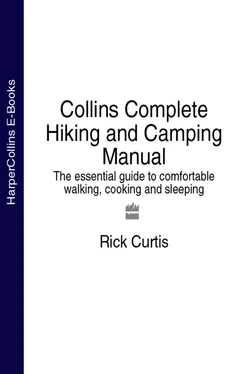Cook before you goA number of delicious meals or add-ons can be made ahead of time and packed with you. Fresh breads, biscuits, muffins, and deserts can add a lot to a trip. Cold salads such as bean salad, houmous, and tabouli can also be made ahead of time.
Pre-cook and freezeFor special meals early in the trip you can pre-cook meals and freeze them in a plastic container. Seal the container well with tape. The food will slowly melt, but should be fine for the first 24 hours. Reheat on the stove for a quick dinner.
EATING ON THE TRAIL
Everyone has different preferences for mealtimes. When hiking, you are expending energy all the time, so you constantly need to replenish that energy. This typically means eating three meals a day. Some people prefer to get up, have a light breakfast, get an early start, and then stop for a bigger meal at midday. Whatever your preference, you should have an ample supply of water and snacks during the day to keep up your energy level. Remember that more falls and injuries take place on hiking trips around 11:00 A.M. and again at 3:00 P.M. than at any other time because blood sugar is low and people are dehydrated. Plan snacks and rest breaks around these times. (See “ Safety and Emergency Procedures.”)
It is also important to take into consideration the different eating habits of the group members. There may be people with food allergies, vegetarians, and those who keep kosher. It is also important to plan a variety of foods, especially for longer trips. Asking trip members about specific dietary needs before shopping will help make everyone on the trip feel included. Finally, a tip for cooking for people with particular dietary restrictions: cook whatever food cannot be eaten by everyone separately. Put it aside in a separate dish for people to add to their own plates.
GENERAL COOKING GUIDELINES, INGREDIENTS, AND RECIPES
Hygiene Before anyone handles food, make sure the person washes his or her hands thoroughly (see “ Keeping Clean on the Trail,”).
Avoid Burning Your Meals Cooking on a backpacking stove is a challenging affair, since some stoves don’t simmer well and none offers the same control as a kitchen stove. Start with a clean pot to avoid burning last night’s dinner. Turn the stove on full only when you are boiling water. Otherwise, turn it down to let the food cook slowly and evenly. It may take longer to cook, but once you burn food in the pot, you’ll taste it the rest of the meal. Check periodically to see if food is sticking to the bottom. If so, turn down the heat or add water. If you are using large pots or frying pans over a small stove burner, you may need to move the pot around frequently to make sure the heat is distributed evenly.
Avoid Overcooking or Undercooking The major cause of overcooking or undercooking is adding ingredients in the wrong order. Start with freeze-dried foods first in cold water and boil for 10 to 15 minutes to re-hydrate. Next add rice or pasta. The last thing to add is thickeners like flour, potato pearls, milk, or cheese.
Spices Spices bring your meal to life. Remember that many sauces, dehydrated soups, and other stocks are already salty. It is best to let people add their own salt when the food is done, rather than oversalt while you’re cooking. Use only a little bit of spice at a time. It takes 5 to 10 minutes for spices to flavor food, so wait and taste before adding more.
Pots If you have extra pots, put water on the stove to boil for hot drinks as soon as you take the dinner pot off. This will also give you hot water for washing.
Leftovers Any solid food left over should be placed in a plastic bag and packed out. Do not bury solid food waste; animals will only dig it up.
Don’t Pack Fuel Near Food Fuel vapors are heavier than air and sink in your pack. They can penetrate plastic bags and contaminate food like trail mix. Food contaminated with fuel is considered a toxic substance and enough of it can make you sick. Carry fuel in an outside pocket of your pack away from food or in the bottom of your pack with the food packed higher up.
Cooking at Altitude At higher altitudes, the air pressure is lower. This allows water to boil at lower temperatures, so you’ll need to plan longer cooking times. For foods that cook in 20 minutes or less at sea level, add 1 minute of cooking time for each 1,000 feet (310 meters) of elevation. For items that take more than 20 minutes at sea level, add 2 minutes of cooking time for each 1,000 feet (310 meters) of elevation. Something that takes 20 minutes to cook at sea level can take twice as long (40 minutes) to cook at 10,000 feet (3,048 meters). This also means that you may need significantly more stove fuel if your trip is at high altitude.
| Elevation |
Boiling Point of Water |
Cooking Time |
| Sea level |
212°F (100°C) |
10 minutes |
| 5,000 feet (1,524 meters) |
203°F (95°C) |
15 minutes |
| 7,500 feet (2,286 meters) |
198°F (95°C) |
18 minutes |
| 10,000 feet (3,048 meters) |
194°F (90°C) |
20 minutes |
| 15,000 feet (4,572 meters) |
185°F (85°C) |
25 minutes |
SAMPLE RECIPES
To me, cooking is a lot like carpentry—the old adage, “measure twice, cut once” becomes “measure twice, cook once.” Once, when I was on a hiking skiing trip, I read a biscuit recipe too quickly and added too much water. In order to salvage the batter, I had to make enough biscuits to feed a small army for a week. By the end of the trip we were all very tired of eating biscuits. In the sample recipes below, you should adjust the quantities to fit the size (and appetites) of your group. Don’t be afraid to invent your own recipes, or check out some of the excellent hiking cookbooks available (see the Bibliography).
Most meals will be one-pot meals. These are often based on pasta, rice, or other grains. Here are the basic cooking directions for pasta and rice:
PastaUse two parts water to one part pasta. Bring the water to a boil. Add salt (1 teaspoon per quart of water). Add the pasta and boil it gently for 10 to 15 minutes or until done. You can use the drained water for soups or carbo-loaded hot chocolate.
Instant RiceUse equal amounts of rice and water. Bring the water to a boil, add margarine (as desired) and salt (1 teaspoon per quart of water). Stir in the rice. Cover, and remove from heat. Let stand for 5 minutes, fluff with a fork and serve.

HOUMOUS

This chickpea spread is a great energy food full of protein and calories. You can make it before the trip or on the trail and pack it in a Ziploc or Tupperware, where it will easily last a week. It makes a great lunch food on pitta or crackers or a nice appetizer before dinner.
2 (12-ounce) cans chickpeas
2 tablespoons olive oil
6 tablespoons sesame tahini
Juice of 3 lemons
4 garlic cloves, minced
Mash the chickpeas with a fork. Add the olive oil, tahini, and lemon juice. If the mix is too thick, add a tablespoon or two of water. Add the garlic. Mix until smooth. Serve with slices of pitta bread. If you want to carry less weight, bring dry houmous, which can be mixed with water on the trail.
Serves 6
TUNA MELTS
This is a great hot lunch or appetizer for the days when you’re feeling lazy and don’t want to spend a lot of time cooking.
Читать дальше













